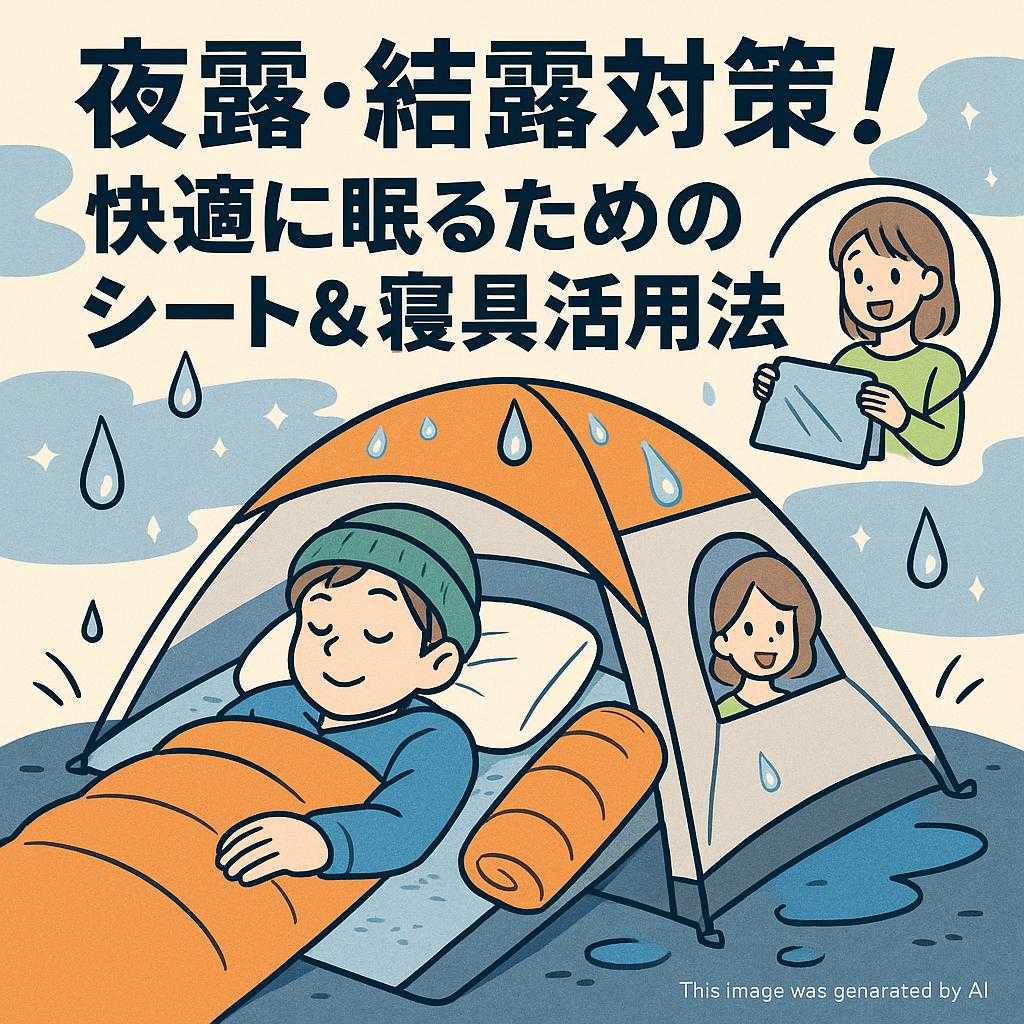
How to Achieve a Comfortable Camping Experience by Tackling Dew and Condensation
When enjoying camping, you can’t avoid the issues of dew and condensation. Especially in colder seasons, moisture inside the tent can turn into condensation, soaking your bedding and belongings. To prevent this, proper use of sheets and bedding is essential. By thoroughly implementing dew and condensation measures, you can create a comfortable sleeping environment.
First, start with choosing the right tent. A double-wall tent with a flysheet can effectively reduce condensation. Additionally, selecting a model with good ventilation features allows moisture inside to escape efficiently. By combining a groundsheet and an inner mat, you can block cold air and moisture from the ground, providing a more comfortable sleeping experience.
Next, consider using dehumidifiers and waterproof sprays. Hanging-type dehumidifier sheets are space-saving and highly effective. Also, treating the tent surface with a waterproof spray makes it less permeable to water droplets.
By preparing in this way, you can free yourself from the discomfort caused by dew and condensation. These methods are simple yet highly effective and are worth trying.
Understanding the Basics of Dew and Condensation
When enjoying camping or outdoor activities, dew and condensation can become significant issues. These phenomena are more likely to occur in colder seasons or humid environments, compromising the comfort inside the tent. Dew is the phenomenon where water vapor in the air condenses into droplets on surfaces at night. On the other hand, condensation occurs inside due to temperature differences between the inside and outside of the tent. Proper measures are necessary to prevent these.
Impact and Measures of Dew and Condensation
Dew and condensation wet the inside of the tent, affecting bedding and belongings. Especially during winter camping, the cold can become severe, and being wet can easily lead to loss of body heat and discomfort. Therefore, using waterproof sheets and bedding is crucial.
Choosing Effective Sheets and Bedding
Double-wall tents are very effective for condensation prevention. This type of tent has a double structure with a flysheet and inner tent, creating an air layer that allows moisture inside to escape easily. Moreover, choosing a model with excellent ventilation further helps control moisture effectively.
Groundsheet and Inner Mat
A groundsheet blocks moisture from the ground, and choosing one with waterproof processing is more effective. Using it in combination with an inner mat enhances insulation, creating an even more comfortable sleeping environment.
Utilizing Dehumidifying Items
Dehumidifier sheets are helpful for managing humidity inside the tent. Hanging-type dehumidifier sheets are space-saving and unobtrusive, making them recommended. They are also useful at home, so buying in bulk can be convenient.
Using a Circulator for Air Circulation
Using a circulator promotes air circulation, reducing condensation caused by temperature differences inside and outside the tent. It is particularly effective when used at powered campsites in cold regions.
Using Water-Repellent and Waterproof Sprays
Water-repellent and waterproof sprays prevent water droplets from adhering to the tent surface. Regular maintenance with spray treatment can sustain its effects over a long period.
Sleeping Bag Cover for Bedding Protection
A sleeping bag cover prevents condensation from adhering to the sleeping bag itself. This reduces the risk of getting wet inside, leading to a comfortable sleep. A water-repellent processed cover is also recommended.
Practical Setup Methods and Precautions
Choosing the right setup location at the campsite is also important. Setting up in a well-ventilated and sunny location helps with dew prevention. Also, be mindful of cold spots due to elevation differences.
Tips for Family Camping
When camping with children, small kids might touch dew-covered areas out of curiosity. Therefore, adults should watch carefully and instruct them not to touch.
Summary: Towards a Comfortable Camping Life
Dew and condensation measures require prior preparation and the right item selection. Start with basic equipment like double-wall tents and groundsheets, and find methods that suit your style. Also, consider incorporating new ideas like dehumidifier sheets and circulators. The optimal solution may vary depending on the situation, but each is worth trying. Above all, planned and careful preparation is the key to a safe and enjoyable outdoor life.
Why Are Dew and Condensation Measures Important?
Dew and condensation occur frequently, especially in cold seasons, and can hinder comfortable sleep. Condensation on window glass increases humidity and can cause mold. Therefore, effective measures are necessary.
Q1: What is the effect of condensation prevention sheets?
A1: Condensation prevention sheets act as insulation when applied to windows and doors, reducing the impact of outside temperatures. This keeps the interior warm and suppresses condensation. Some products also have UV-cut effects, making them useful as interior decor.
Q2: What kind of bedding is effective against dew?
A2: Using bedding with excellent absorbency and quick-drying properties effectively manages nighttime moisture. For example, sheets and mattress pads made from high-performance materials help with humidity control. Additionally, highly breathable pillow covers and comforters are recommended.
Q3: What types of condensation prevention goods are there?
A3: Condensation prevention goods include “insulation type” and “absorption type.” The insulation type blocks heat between window glass and indoor air, while the absorption type absorbs and evaporates formed droplets. Combining these allows for effective condensation prevention.
Q4: Are there methods to prevent condensation other than sheets?
A4: Besides sheets, there are various condensation prevention items like sprays and heaters. Sprays create a coating layer on glass surfaces to prevent water droplets from adhering. Additionally, small heaters are effective in reducing temperature differences near windows.
Approach to a Comfortable Sleep
Choosing the right goods and bedding for dew and condensation measures is crucial. By understanding each feature and selecting items that suit you, you can achieve a comfortable sleeping environment all year round.
Conclusion: Dew and Condensation Measures for a Comfortable Camping Experience
Dew and condensation measures in camping are crucial for achieving a comfortable outdoor experience. First, by choosing double-wall tents or models with good ventilation, you can efficiently release internal moisture and reduce condensation. Furthermore, combining a groundsheet and inner mat blocks cold air and moisture from the ground, improving sleeping comfort. Additionally, actively use items like dehumidifier sheets and circulators to prevent condensation caused by temperature differences inside and outside the tent. Regular maintenance with water-repellent and waterproof sprays prevents water droplets from adhering. Using a sleeping bag cover also minimizes the impact on the bedding itself. These measures are simple yet effective and worth trying. With planned preparation and the right item selection, a safe and enjoyable outdoor life can be achieved.
